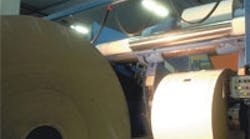Gear-type couplings have long been used in paper machinery drives. But today's emphasis on faster speeds and more accurate controls, combined with higher temperatures and a reduced work force, tend to magnify problems with gear couplings. As a result, coupling failures are said to be the most common reason for unscheduled downtime in pulp and paper mills.
Paper machines must maintain roll surface speed to ensure constant web tension. Otherwise, speed variations can cause flaws or tears in the paper. Early machines were driven by line shafts, with tapered cone pulleys to adjust roll speed. Operators simply set the speeds as close as possible with dial tachometers and didn't change them during operation. Gear couplings, though susceptible to wear, performed well under these conditions because wear-related changes to system parameters occurred slowly.
Upgrading the machines to direct drives with digital controls accelerates wear of these couplings. Direct drive machines with modern digital controls are also more sensitive to backlash in the drives. Paper mills that retrofit the machines with disc couplings, however, eliminate the backlash and boost control precision, thus helping to ensure high product quality.
Up to speed
Modern paper machines generally use multiple drives with synchronous speed motors, each one driving a separate roll through a geared speed reducer. Digital controls sense roll speeds to within milliseconds, making continuous adjustments to maintain optimum web tension. This precise tension control helps the machine turn out higher-quality paper by reducing the major cause of many flaws such as wrinkling and tearing.
Each drive contains a high-speed coupling -- generally a close-coupled, double-flexing gear coupling -- between the motor and speed reducer, plus a long-span gear coupling or universal joint between the reducer and the roll. The high-speed coupling typically operates at the motor's synchronous speed, between 1,180 and 1,500 rpm.
On the low-speed side, rigid hubs normally are mounted to the reducer and the roll. The coupling then becomes a jackshaft, mounted to the rigid hubs with a flexible hub on each end. These couplings typically operate at about 300 rpm, and even slower on pulp machines.
Coupling clearance compounds problems
A gear coupling requires clearance or backlash between the meshing gear teeth so it can slide while misaligned. As the coupling wears, this backlash increases. But backlash works at cross-purposes to the precise speed control required for paper machines. As the digital control senses this backlash, it constantly tries to compensate for it. However, the resulting false signals make it difficult to control speed accurately, causing imperfections in the paper.
Further, the couplings operate in a hot, humid environment that not only corrodes unprotected steel components, but causes the lubricant and seals to break down, which shortens coupling life. Batch-lubricated couplings typically used on paper machinery must be torn down, inspected, and relubricated every 6 to 12 months. Newer batch-lubricated couplings claim longer life but haven't been in service long enough to confirm these claims.
Another problem with gear couplings in high-speed service is thrust lockup, a condition in which frictional forces prevent the coupling components from sliding freely during axial shaft motion.
Gear couplings can be visually inspected only by stopping the machine, disassembling the coupling housing, and cleaning off the lubricant. Then the teeth are inspected for wear and the coupling replaced if necessary. Replacement typically takes at least 8 hours. Long-span couplings add to the difficulty because they have heavy solid-steel intermediate shafts that require two people with a hoist to perform an inspection. So most mills have reduced their coupling inspections to once or twice a year. But this means gear coupling wear is likely to progress further, making the couplings less reliable.
Disc pack solution
These problems have been overcome with Thomas disc couplings designed to fit the needs of paper mill applications. These devices have replaced gear couplings in a large number of mills worldwide. They have no wearing parts, no backlash, and require no lubrication. Moreover, corrosion-resistant stainless steel disc packs provide long service life.
Paper machines use a close-coupled disc coupling for the high-speed side, between motor and speed reducer, and a long-span jackshaft version for the low-speed side, between reducer and roll.
The high-speed disc coupling replaces a close-coupled gear coupling. Its diameter normally fits within the same space as a standard gear coupling. An axially split center member lets you replace the disc packs without moving the connected equipment.
On the low-speed side, a longspan disc coupling bolts to gear coupling hubs already mounted on the reducer and the roll. The center section is a hollow tube, which is much lighter and easier to handle than the solid shaft of a gear coupling, and it reduces weight on the connected equipment.
Disc couplings require closer axial position adjustments than gear couplings, and this is accommodated by adjustment shims. The long-span couplings can also be supplied with slip splines that allow more axial movement.
When properly installed and aligned, disc couplings provide long service life without maintenance -- in some cases 30 to 40 years. Excessive misalignment can distort the flexible disc packs, leading to eventual fatigue fractures in the outer part of the discs. Periodic visual inspections let you detect such failures without disassembly. And the discs can normally be replaced during a scheduled shutdown.
David H. Hendrickson is an industry specialist for the Thomas Coupling Div., Rexnord Corp., Warren, Pa.



